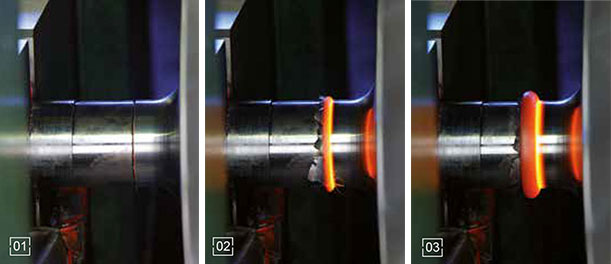
เทคโนโลยีการเชื่อมด้วยแรงเสียดทาน จาก KUKA
เทคโนโลยีการเชื่อมด้วยแรงเสียดทานของ KUKA นั่นก็คือกระบวนการเชื่อม โดยใช้แรงกดดันให้ชิ้นงานเชื่อมเข้ากันได้ในแนวหมุน โดยเทคโนโลยีนี้ได้มีบทบาทสำคัญในอุตสาหกรรมการเชื่อมชิ้นงาน เช่นการลดเวลาการทำงานเชื่อม การเชื่อมวัสดุต่างชนิดกัน และการเชื่อมแบบกำหนดมุม การเชื่อมทำให้เกิดนวัตกรรมใหม่ๆ ในการออกแบบผลิตภัณฑ์ และการผลิตที่สมบูรณ์แบบ
กระบวนการทำงานของ Friction welding คือ เริ่มจากการจับยึดชิ้นงานที่จะเชื่อมกันให้แน่น โดยชิ้นงานตัวหนึ่งจะเคลื่อนไหวโดยการหมุน โดยการกดเข้าหากันด้วยแรงที่เหมาะสม การเสียดสีสัมผัสในขณะชิ้นงานหมุนด้วยตัวมันเอง ทำให้เกิดความร้อนที่ผิวงานจนกระทั่งชิ้นงานที่เคลื่อนหมุนหยุดลง พร้อมกับแรงกดที่เพิ่มขึ้นจนเกิดการเชื่อมติดกันของสองชิ้นงาน ส่วนของชิ้นงานที่เกิดความร้อนด้วยวิธีการนี้จะมีขนาดเล็กกว่าการเชื่อมแบบอื่นๆ และไม่เกิดรอยนูนการการเชื่อมอีกด้วย
KUKA – Friction Welding Technology
Friction welding, or rotational friction welding, is a pressure welding process. One of two parts to be welded must be rotationally symmetrical. Friction welding makes use of the heat generated by friction. The parts are rotated and moved towards one another so that their contact surfaces touch. Once the material has been heated to the point where it becomes plastic, the parts are positioned and pressed against one another with high pressure.
The advantage of friction welding is that different materials (steel/brass, steel/copper, steel/aluminum, aluminum/ceramic, …) can be joined together. Application examples include valves for internal combustion engines, drill pipes, hydraulic components, printing rollers, cross members and much more. The heat-affected zone is significantly smaller for friction welding than for other welding processes. No weld pool is formed in the joining zone.
ขบวนการเชื่อมด้วยแรงเสียดทานแบบความเร็วสูง
- ขั้นตอนตั้งต้น
ชิ้นงาน 2 ชิ้นถูกจับยึดอย่างมั่นคงในเครื่อง ชิ้นงานหนึ่งจะถูกหมุน - เกิดความร้อน
ชิ้นงานทั้ง 2 ชิ้นจะถูกกดเข้าหากันด้วยแรงที่กำหนด การหมุนและการสำผัสกันจะสร้างแรงเสียดทาน ทำให้การการเชื่อมบนหน้าสัมผัสน - การเชื่อม
ในช่วงเวลาที่ถูกกำหนด การหมุนของชิ้นงานจะหยุดลงแ ละแรงกดจะถูกเพิ่มขึ้น ซึ่งจะทำให้เกิดการเชื่อมด้วยแรงเสียดทานเกิดขึ้น
High-speed friction welding process
- Initial situation:
Both workpieces are firmly clamped into the machine; one workpiece is rotated. - Heating:
The two workpieces are pressed together with a defined force; the rotation and contact force generate friction which causes the weld surfaces to heat up. - Welding:
At a defined moment in time, the rotating workpiece is braked and the contact pressure is increased. This creates the friction-welded joint.
จุดเด่นของการเชื่อมด้วยแรงเสียดทานของ KUKA
- สามารถเชื่อมวัสดุที่ต่างกันเข้าด้วยกันได้ เช่น เหล็ก/ทองเหลือง เหล็ก/ทองแดง เหล็ก/อลูมิเนียม อลูมิเนียม/เซรามิค เป็นต้น ตัวอย่างชิ้นงานในอุตสาหกรรม เช่น วาล์วสำหรับเครื่องยนต์สันดาปภายใน ก้านเจาะ อุปกรณ์ไฮดรอลิค ลูกกลิ้งแท่นพิมพ์ และเหล็กขวางในโครงสร้างรถยนต์ เป็นต้น
- ลดต้นทุนการผลิตเนื่องด้วยสามารถการเลือกใช้วัสดุที่มีราคาสูง ในปริมาณจำกัดโดยใช้เฉพาะบริเวณที่จำเป็น
- คุณภาพการเชื่อมสูงมาก หลีกเลี่ยงปัญหาที่จะเกิดขึ้น โดยชิ้นส่วนซึ่งถูกเลือกใช้ในขบวนการผลิตทุกชิ้น ส่วนจะต้องมีการตรวจสอบชิ้นส่วนที่ได้รับการปรับปรุง
- น้ำหนักที่เบาของชิ้นส่วนเป็นสิ่งสำคัญที่อุตสาหกรรมยานยนต์ต้องการ การเชื่อมด้วยแรงเสียดทานจึงเป็นการปูทางสู่การขับเคลื่อนของอนาคต
High-speed friction welding process
- Cost reduction
The state-of-the-art friction welding processes make it possible to limit use of expensive material to those points that are relevant for the component. - Very high weld quality
Avoid unnecessary problems – opt for a production process in which every component is validated. - Component optimization
The automotive industry demands solutions that reduce weight – welding paves the way for the mobility of the future.
